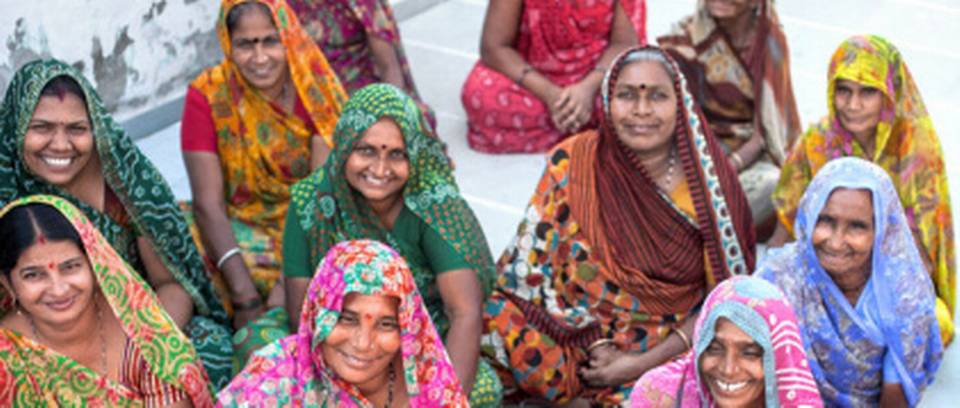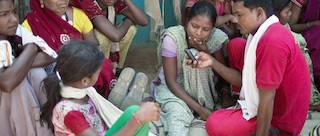This article on The Hindu Business Line discusses initiatives including Mobile Vaani as using ‘basic mobile phones [to make] all the difference between hardship and empowerment in rural India’. Originally posted here. SIBI ARASU RASHMI PRATAP

Basic mobile phones are making all the difference between hardship and empowerment in rural India
In the early hours of a March day in 2011, just a few months after the Maoists were declared the ‘greatest threat to India’s internal security’, Tadmetla village in Chhattisgarh’s conflict zone awoke to its houses set on fire. It was the third such incident in as many months. And like the two previous episodes, when security forces burnt and rampaged the villages to ‘send the Maoists a message’, it received no coverage in the national or state media.
However, this time a phone call went out, not to the state machinery or to the mainstream newspapers or TV channels, but to CGNet Swara, a voice-based portal where anyone can call in to report grievances or share three-minute stories that don’t find a mention or video space anywhere else.CGNet Swara posted Tadmetla’s story to its Yahoo group. A week later, the international media carried the report, which was then picked up by the media in Delhi, leading to inquests. One call from a basic phone had helped ensure the horrendous act of violence didn’t go unreported.
Cut to Rajasthan’s Khinswar taluka, circa 2012: Farmer Bhanwar Das was battling ‘flower drop’ in his cotton crop — the flowers fell off before maturing into cotton bolls. After trying various remedies and failing, Das decided to call IFFCO Kisan Sanchar Ltd (IKSL) for a solution. He was directed to spray Planofix — 1ml in 4 litres of water. He spent ₹80 on the pesticide and watched his output increase from 12 to 18 quintals per hectare. Just one call saved his crop and his family.
In neighbouring Gujarat, the Rudibens — women entrepreneurs belonging to the Rural Distribution Network (RUDI) — have multiplied their incomes through a simple mobile application called the RUDI Sandesha Vyavhar.
Rudibens buy farm produce directly from farmers and sell to rural households after cleaning, grading and packaging it. Before the app was developed, Rudibens travelled long distances to place orders and collect the stock from central warehouses. Often, they arrived at the warehouse to find their orders were not ready. With the app, they can order from the field and receive updates through automated text messaging, saving them time and money.
Ring in the development
Mobile phones have brought even remote villages and households into the communication network grid. A motley bunch of community groups, NGOs and cooperatives has made the simple feature phone a powerful platform for rural India to communicate, resolve problems and improve agricultural production and supply chain systems.
According to the World Bank, a 10 per cent increase in mobile and broadband penetration increases per capita GDP by 0.81 per cent and 1.38 per cent, respectively, in developing countries. India seems well on its way to proving them right. The central government too has recently announced the revival of the ₹5,000-crore plan to distribute basic handsets to 25 million rural households.
Jasuben Dipakbhai Rathod of Haripar village in Gujarat, saw her sales multiply 10 times over, thanks to her mobile phone. “With the RSV app, I am able to sell RUDI products, such as dals, grains and spices, worth ₹25,000 every month in my village. This helps me meet the basic needs of my household,” says Rathod, who earlier pawned her gold to make both ends meet.
The app, developed jointly by Vodafone Foundation, Cherie Blair Foundation for Women and SEWA (Self-Employed Women’s Association), also helps RUDI members save on time, conveyance costs and allied expenses. “Their incomes have increased. Rudibens are literate and trained in using the app. It can be operated by anyone with basic education,” says Umadevi Swaminathan, MD, RUDI.
Help, a two-way street
Broadcast media does not allow for two-way interaction, says Hemant Joshi, Partner, Deloitte Haskins & Sells. He sees the answer in ICT, or information and communications technology. “Through ICT you can create interactive platforms, and people can access the best of content, communicate, interact and improve lives,” he says. His views are echoed by S Srinivasan, CEO of IKSL, which is a joint venture between farmers’ cooperative IFFCO and Bharti Airtel. “Educating farmers across India was tough. With the improvement in ICT and mobile penetration, we decided to use this medium to reach out to the farmers.”Sugarcane farmer Mangat Singh in Muzaffarnagar, Uttar Pradesh, noticed dark red spots on the leaves of his crop. While this fungal disease is best avoided by cultivating only resistant sugarcane varieties, he was advised to spray a chemical mix of Captan and Hexaconazole. This cost ₹1,050 per acre, but his yield improved to ₹4,350 per acre. “I would have lost my standing crop otherwise,” he says.
Speed-dial accountability
By empowering people to raise their voice against injustice through a single phone call, CGNet Swara has become a trendsetter in a new kind of citizen journalism, replicated in countries as far away as Indonesia and Somalia. Similarly, Mobile Vaani, an initiative by the Delhi-headquartered Gram Vaani, has become the ‘Facebook’ of rural India.
The primary school at Sadokhar village in Rohtas district, Bihar, got a teacher only after villagers took up the issue on Mobile Vaani and an enquiry was ordered. “Nothing about what happens here used to come on TV or even the local papers. After Mobile Vaani, we got teachers in our area after a gap of two years,” says 19-year-old Amarjeet Kumar, a regular user.
After the incident at Tadmetla, CGNet Swara has become a staple source for news from the infamous ‘red corridor’. Mobile Vaani, on the other hand, has been credited with spurring discussions on issues ranging from ways to improve the public distribution system to raising awareness against domestic violence.
Since it went live in 2010, CGNet has received more than three lakh callers, who either listen in or file their own stories; more than 6,000 reports have been translated into English and posted on its website and online groups. Mobile Vaani, which enjoys a reach of more than 40,000 people in Jharkhand alone, receives an average of 3,000 calls every day.
The tech behind it
“All of us are using IVR (Interactive Voice Response),” says Ritesh Datta, director-programmes at Gram Vaani. This technology allows people to interact with computers using a combination of their voice and numbers pressed on their keypad.
Each caller gets an automated voice message and a few simple options. For instance, on CGNet, the caller can choose between listening to stories or filing her own. Importantly, all of this is free of charge for the caller, with the service agencies bearing the cost so far.“In terms of infrastructure, our requirements are very basic… a few computers and a laptop that also acts as a server. We create backups of every call we receive,” says Subhranshu Choudhary, the founder of CGNet Swara.IKSL sends out five free mobile messages every day with information related to crop, soil, market rates and the weather. “I listen to it carefully as they share bazaar bhaav (prices) and tell us what to do in case of poor rains or how to improve soil fertility,” says Das, the cotton farmer.
Over 30 lakh farmers are now a part of the IKSL network. They have to subscribe to the Airtel Green SIM card marketed by IKSL’s sales team. Apart from getting the free alerts, subscribers can also dial a short code to get responses to specific queries without any charge. On average, 100 farmers call every month seeking solutions to their problems, says Srinivasan.IKSL has tie-ups with Indian Meteorological Department and other institutions for its information services. Local universities develop the advisories based on data related to temperature, humidity, rainfall and other factors.
With its coverage of 19 states, IKSL has divided the country into 108 agro-climatic zones. “We know the cropping pattern and calendar for each crop in every zone — from pre-sowing to post-harvesting. We know what the farmer will be doing at a certain point of time in the year and send advisories accordingly,” adds Srinivasan. So, if it is likely to rain, IKSL will advise farmers against harvesting the crop to prevent spoilage.
Social vs. commercial
Observing that initiatives like Mobile Vaani and CGNet Swara give people a voice and promote accountability, development economist Jean Dreze says there is potential to do more. “Mobiles would have even more wide-ranging uses if creative energies were more focused on social applications as opposed to commercial applications,” he says.
While rural India is not exactly priority for application developers, NGOs and cooperatives are not about to give up either. SEWA is looking at spreading the Rudiben network to more areas. CGNet recently launched Adivasi Swara, the first Gondi language radio service. It plans to reach out to more Adivasi communities such as the Santhals and Bhils, besides setting up separate stations such as Swasthya Swara for health and Kanoon Swara for law-and-order issues.
Mobile Vaani, meanwhile, is readying for more issues, partners, regions and States. “Also, it is a great marketing platform, whose potential is only beginning to be noticed,” says Datta of Gram Vaani.
Meanwhile, for those at the receiving end of this mobile-enabled revolution, the dreams are only getting bigger. As Gokaran Verma, a CGNet user from Bemetara district in Chhattisgarh says, “The poor here now have a strong voice. It won’t be long before talented Adivasi journalists emerge from our region.”
Featured image was posted on the news website courtesy CG Net Swara.



